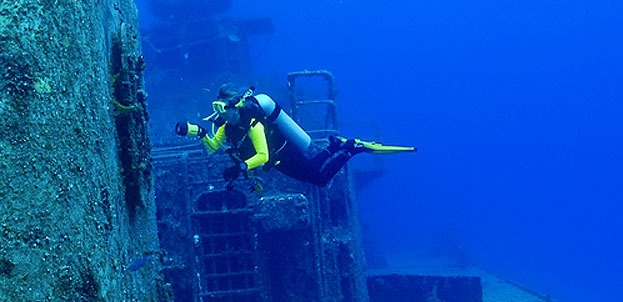This is a guest blog post by Mike Ketcham
Dive lights are magical, they add color to the underwater world (something many people forget) and allow divers to see sights and visit places that would otherwise be drab, dark or inaccessible. Recent advances in lighting and battery technology have made modern dive lights significantly better than those of just five or ten years ago. As dive light technology has advanced, so have the number of features, brands and types of dive lights. Whether you are upgrading from an older light or purchasing a torch for the first time, its easy to be overwhelmed by all the available choices. To simplify the process of selecting a dive light, we’ve reduced the major decisions down to four basic questions. Once you answer (or consider) these questions, choosing a dive light will be pretty straightforward.

How do you plan to use it?
Sounds like an obvious question, but many divers skip past this one. The best way to choose a light is to understand what your particular needs as a diver are, and then match them up with the right type of light. Here are some examples of specific ways you might use a diving light. This is not an exhaustive list, but it should get you thinking.
Do you plan to use it on daytime dives to look under rocks and into little caverns to see what sea life is hiding there? If so, a small handheld narrow beam light that you can store on your BCD when not in use may be your best bet.
Do you plan to use it during night dives to view broad seascapes? If so, consider a dive light with a wider beam and perhaps a higher lumen rating.
Do you plan to just use it on occasion for a mix of day and night dives and for the occasional camping trip with the kids? A small handheld aluminum light with an adjustable beam angle may have the versatility you need.
Seeking a primary torch for technical or exploration diving? That’s a whole different world – tech lights are designed to be always on and very durable. They typically have a bright, tight, penetrating beam and very long battery life.
Want to expand the capabilities of your new GoPro or Sport HD action camera? You’ll need a video light (or two) with a wide, consistent beam and no hot-spots. You’ll also probably need a rig to mount the camera and light(s) together.
What type of lighting technology fits your needs?
For 99% of divers, an LED dive light is clearly the best choice. LED (Light Emitting Diode) lighting technology has evolved to the point that it has eclipsed other of “bulb” types. LED lamp life is extraordinary, LEDs are extremely durable and LED light units are affordable. Most importantly though, LEDs are much more electrically efficient than other lighting technologies. Greater efficiency means longer battery life, greater lumen output, or a combination of both for a given battery set. With the advances in LEDs, the days of incandescent bulbs (Halogen/Xenon) have drawn to a close and most manufacturers no longer sell them. Some divers still prefer HID (High Intensity Discharge) technology in a few specialized applications, but those uses do not fall within the scope of most recreational divers. Unless you have a very specific reason to do otherwise, choose an LED dive light.
What type of batteries do you prefer?
There are three major types of dive light batteries and each type has advantages and disadvantages, so this decision is all about tradeoffs.
Traditional alkaline batteries (e.g., AAA, C) are inexpensive and available almost everywhere globally. Their main drawback is a lower level of performance, typically in the form of reduced battery life.
CR123 lithium (3V photo) batteries have excellent performance, but are more expensive than alkaline batteries and may not be available in some remote diving locations. CR123 batteries can be also be a hassle if you pack them in your carry-on luggage when traveling by air in some parts of Europe. Some people dislike lithium batteries from an environmental standpoint, but they can be recycled.
Internal rechargeable batteries are typically the choice of those who dive frequently. They have low operating costs and are the best choice from an environmental standpoint since they are reusable. They do however require both time to recharge and access to power. Rechargeable batteries also don’t hold a charge well in storage, so they are not be the best choice for backup lights.
What brand should you choose?
This is the question we hear most often. There are a number of very reliable brands on the market today. Many manufacturers tend to focus on a particular type of light, so the brand you choose may depend largely on what type of diving light best matches your particular needs. There are also many knock-off and less reliable brands (some very well known) on the market today. Stay clear of them, as they can ruin a dive (or worse) pretty quickly. To find a dependable light, let your favorite scuba retailer to point you in the right direction. It’s unlikely that they’ll carry brands they believe to be unreliable.
Mike Ketcham is the General Manager of Dive Lights Direct. To learn more about dive lights and related scuba stuff, check out the Dive Light Blog.

